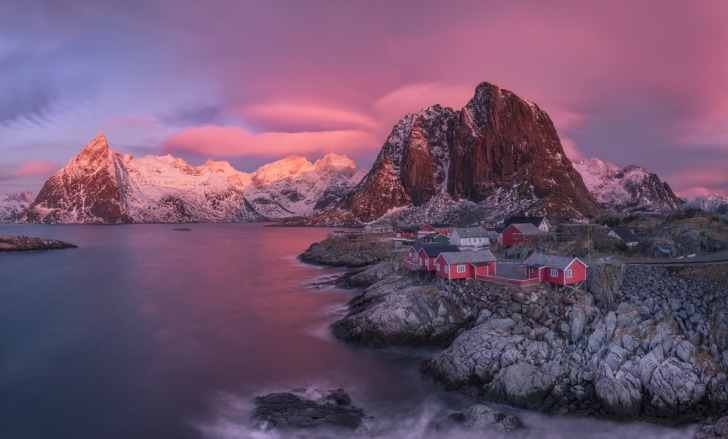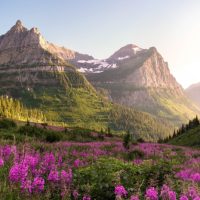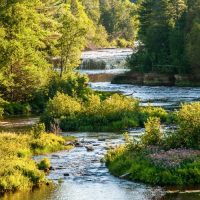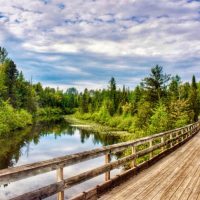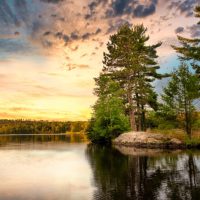Alaska has more than its fair share of dangerous wildlife, along with extreme weather conditions.
Are snakes a concern in Alaska, or is it a snake-free state?
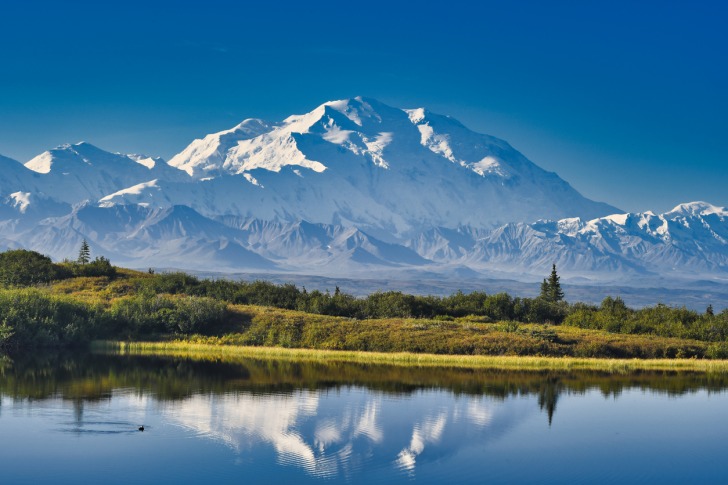
Contents
So… Are There Snakes in Alaska?
The short answer is no, there are no snakes in Alaska.
However, the truth is a bit more nuanced.
There are indeed no established native snake populations in Alaska.
This means that there aren’t groups of any type of snake living in the wild in the state.
However, snakes and snake remains have been found in the snowy state.
Why Aren’t There Snakes in Alaska?
Snakes don’t do well in Alaska due to the weather and sunlight.
They are cold-blooded, which means they rely on the outside temperature and sunlight to keep them warm.
This is why you’ll often see snakes basking in the sun.
It’s their way of warming up and regulating their body temperature.
Temperatures in Alaska are well below freezing for several months of the year.
In the warmer months, temperatures can rise to 80 or even 100 degrees in lower elevations.
During the winter, however, temperatures drop to -30 to -35 degrees, which is about 60 degrees below freezing.
Because snakes are cold-blooded, they can’t survive these temperatures.
Alaskan winters include lots of snow. Snakes don’t get around well in the snow, because they don’t have legs.
This makes it nearly impossible for them to find food in the winter.
Alaska doesn’t have traditional days and nights for part of the year.
They have two months of dark, where there’s no full sun at all.
Most areas do have a short twilight period during this time, but much of the day is completely dark.
There’s also a period where they have sun 24 hours a day, usually from mid-April through August.
Snake Species in Alaska
There are no native snake populations in Alaska, but there have been occasional snakes found there.
Let’s take a look at them.
Garter Snakes
The most common snake found in Alaska is the garter snake.
Garter snakes are present throughout the continental U.S.
Chances are you’ve seen one at some point in your life.
These snakes are fairly small, usually about a foot long.
They are black or brown, with three stripes that run down their back.
These are said to look like women’s garters, which is where they get their name.
Garter snakes technically have a very mild venom that is neurotoxic.
However, it’s not strong enough to cause any serious harm to humans.
These snakes are believed to travel to Alaska from their more southern habitats.
Due to the harsh conditions, rarely, they survive too long in Alaska.
Sam the Alaskan Python
Sam is the most famous, or infamous, snake found in Alaska.
Sam is a Burmese python.
He weighed 100 pounds and was 17 feet long.
He wasn’t destined to live in the Alaskan wild.
Instead, he lived as a pet.
One day, Sam disappeared.
His owner reported him missing.
There were no reported sightings of Sam.
His owner said he had recently eaten a large rabbit, so he wasn’t looking for food.
No one knows where Sam went, but about 2 weeks later he came home.
Is it Safe to Go on a Trek in Alaska?
Alaska does have some hazards that you should be aware of.
It’s often considered the most dangerous state in the U.S.
There are two major types of hazards.
These are weather-related hazards and wildlife hazards.
Weather-related hazards are potentially the most dangerous concern in Alaska.
The rate of deaths by hypothermia is 10 times higher than the U.S. average, at 3 per 100,000 people.
In addition to cold temperatures, blizzards are common and can strike without warning.
Wildlife Hazards
Bears are one of the most dangerous wildlife hazards in Alaska.
You’ll find polar bears, of course.
Grizzlies and black bears also call Alaska home.
From 2000 to 2017, there were 68 bear attacks, with the majority of these being from grizzly bears.
10 of these attacks were fatal.
The Kodiak bear only lives in Alaska.
They are larger than the grizzly and about the same size as a polar bear.
While they are fairly common in Alaska, there’s only been one human fatality from these majestic creatures in the last century.
Moose is another animal you should keep an eye out for.
They are much more common than bears and are responsible for more fatalities each year than bears.
These massive animals cause 5 to 10 fatalities each year.
It’s important to note that dog attacks are more common than either bear or moose injuries, with 467 hospitalizations from 2000-2017.
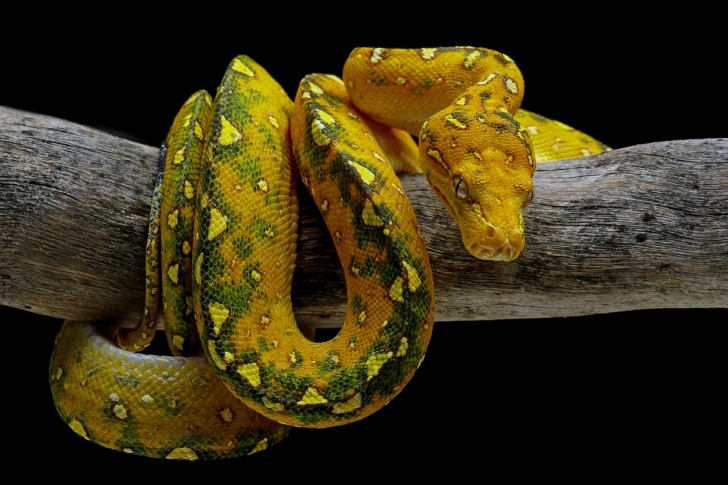
Interesting Snake Facts in Alaska
Alaska doesn’t have any native snakes, but it does have a mysterious snake-like creature, according to legend.
The creature lives in the water near Key and King Islands.
It has the body of a serpent and is often depicted with seal-like flippers.
Inuits call the creature Tizheruk, and say that it has been known to snatch unwitting people from nearby piers.
The legend states that it can move around on land, but it’s slow and vulnerable out of the water.
Before you dismiss this as pure myth, it’s important to note that native cultures in Canada have a similar creature.
There’s been a more recent sea serpent sighting in Alaska.
It appeared in 2016 and was even recorded on video.
Unfortunately, authorities determined that the Alaskan Ice Monster was simply rope with ice attached to it.
3 Safety Tips for Exploring Nature in Alaska
Alaska doesn’t have dangerous snakes, but it is important to follow some basic safety tips when exploring The Last Frontier.
1. Be Prepared for the Weather
Alaska weather can be deadly, so it’s important to be prepared.
Summer temperatures can be surprisingly warm, while winter temps drop well below freezing.
If you are exploring Alaska in the winter, be sure to have properly rated gear, including a parka.
2. Don’t Go Alone
Because of the extreme conditions in Alaska, you shouldn’t roam the state alone.
You should always use the buddy system, which means having at least one person with you at all times.
3. Pack a Survival Kit
Before heading out to Alaska, you should pack a survival kit.
Be sure to include high-energy foods, matches or a lighter, rain gear, and a compass.
Summary
Alaska is generally snake-free, but it’s not without danger.
Alaska’s natural landscapes are breathtaking and certainly worth exploring.
However, you should exercise caution when enjoying Alaska’s pure frontiers.
Alaska Safety Overview
READ THE FULL REPORT: Alaska Safety Review
Safety Index:
- OVERALL RISK: MEDIUM
- TRANSPORT & TAXIS RISK: LOW
- PICKPOCKETS RISK: LOW
- NATURAL DISASTERS RISK: MEDIUM
- MUGGING RISK: HIGH
- TERRORISM RISK: LOW
- SCAMS RISK: MEDIUM
- WOMEN TRAVELERS RISK: LOW
Frequently Asked Questions
Can snakes survive in Alaska?
Most snakes can’t survive in Alaska for very long.
Garter snakes are sometimes found in the state.
There are no large populations of them, but a few may survive in the southern parts of Alaska.
Does Alaska have any reptiles?
Alaska isn’t just snake-free.
It’s almost completely reptile-free.
The exception is sea turtles, which are rarely spotted in the Pacific Ocean off the coast of Alaska.
Can you have pet snakes in Alaska?
Yes.
Alaska has a law stating that you can’t possess non-domestic animals.
However, it has a very long list of exceptions, including snakes and other reptiles.
This means it’s legal to have a pet snake in Alaska, and no permit is required.
